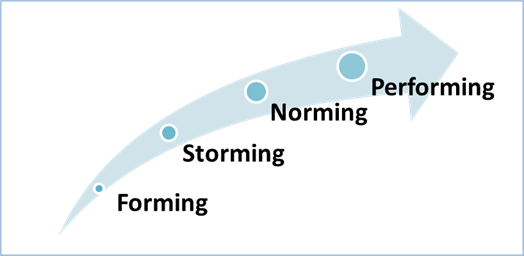Team Stages– From the time a team is put together, it goes through four stages to become a highly effective team. The collective reference for these stages is the ‘forming’ model. Teams are more successful when they transition back and forth between these stages as circumstances change.
1. Forming stage
Team leaders provide a structure where there is a clarification of expectations about the initiation of team processes. Work that needs to be accomplished is:
- team member introduction,
- team resource assessment,
- and objective definition.
Commonly encounter issues that need overcoming are:
- the team leader’s taking on most of the work,
- team members not organized around a common objective,
- and team not taking advantage of all the team resources.
The team execution process at this stage is a wait and see attitude, where the team process is usually noticed but avoided.
2. Storming stage
Team leads need to coach the team in maintaining focus on the:
- goals and expectations,
- managing the team process and conflict resolution,
- generating ideas,
- and explaining decisions.
Work that needs to be accomplished is:
- identifying team member expectations,
- discussing differences,
- and conflict management.
Issues that surface are:
- team members feeling unsatisfied and/or overburdened,
- and lack of contribution.
The status of the team execution process at this stage is the formation of cliques because the general perception is that the effort does not require teamwork.
3. Norming stage
Team leads primarily act as a facilitator who provides:
- encouragement,
- helps with consensus building,
- and gives feedback.
Attention needs to be given to:
- resolving differences through establishing ground rules,
- developing trust,
- and discussing directly how better to work together.
Common issues that arise are:
- ongoing disagreements between team members
- and team members’ working at cross-purposes.
The status of the team execution process at this stage is general support for leadership, with the sharing of leadership among the team.
4. Performing stage
Team leads need to facilitate the team process, where there is a delegation of tasks and objectives. Attention needs to be given to:
- objective achievement,
- team member satisfaction,
- and collaboration.
Issues that surface are:
- unfinished work and
- not celebrating success.
At this stage, the status of the team execution process is that members are not dependent on the designated leaders, where everyone shares the responsibility for initiating and discussing team process issues.

Apply for Six Sigma Black Belt Certification Now!!
http://www.vskills.in/certification/Certified-Six-Sigma-Black-Belt-Professional



